Employee Engagement Throughout the Employee Lifecycle: Hotel Industry
VerifiedAdded on 2023/06/16
|10
|3042
|68
Report
AI Summary
This report examines employee engagement strategies within the hotel industry, focusing on the employee lifecycle. It highlights the role of human resources in engaging workers, discussing methods such as learning opportunities, communication, and external activities. The report emphasizes the advantages of employee engagement, including reduced stress, increased commitment, and enhanced productivity. It delves into each stage of the employee lifecycle—attraction, recruitment, onboarding, career development, retention, and separation—providing examples of how hotels can engage employees at each stage. The Zinger Model is introduced as a framework for enhancing employee engagement by focusing on connection, authentic relationships, recognition, and engagement. Examples from hotel chains like Intercontinental Hotels Group and Hilton Hotels illustrate practical applications of these strategies, emphasizing the importance of investing in employee well-being and professional development to reduce turnover and improve performance.
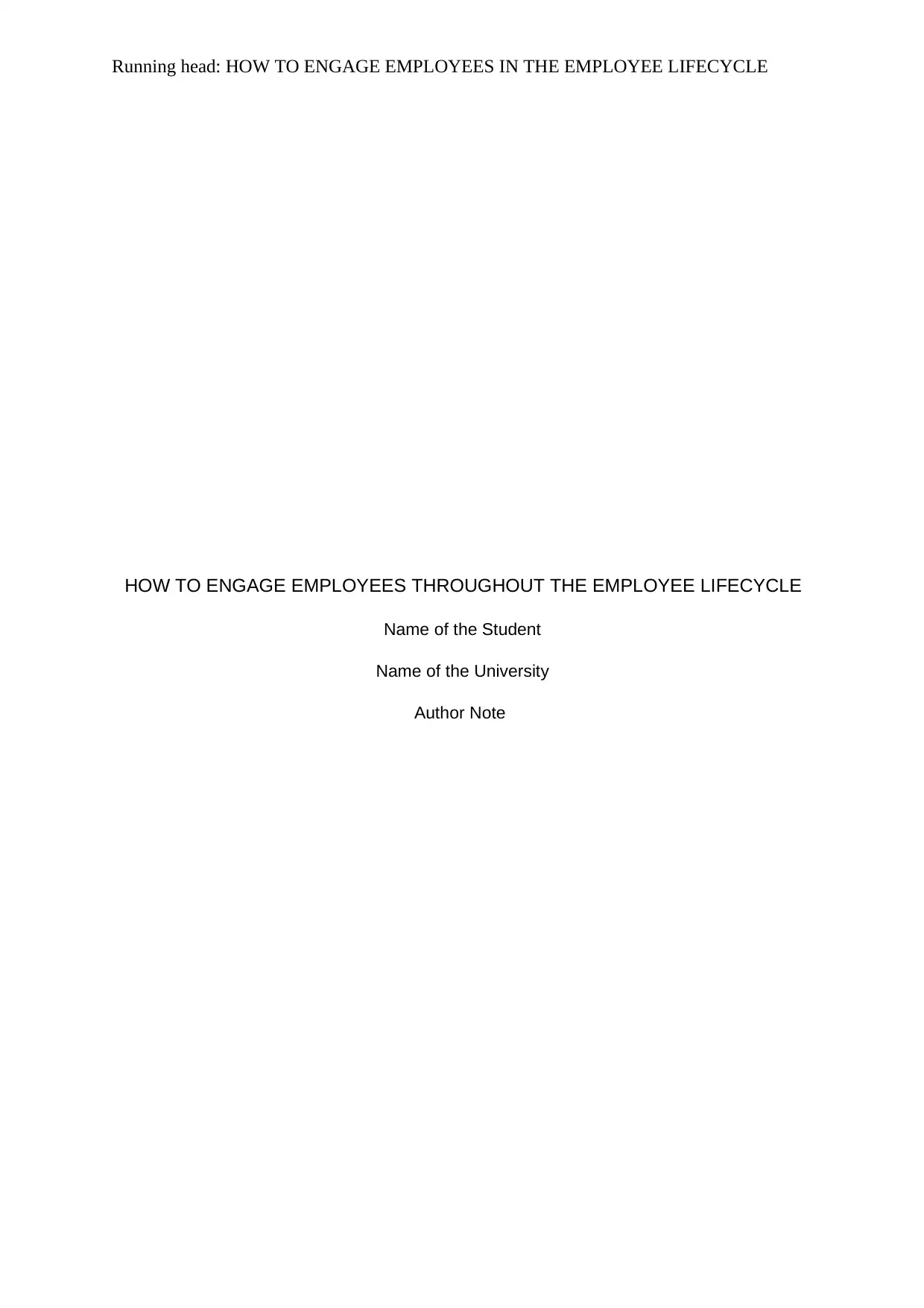
Running head: HOW TO ENGAGE EMPLOYEES IN THE EMPLOYEE LIFECYCLE
HOW TO ENGAGE EMPLOYEES THROUGHOUT THE EMPLOYEE LIFECYCLE
Name of the Student
Name of the University
Author Note
HOW TO ENGAGE EMPLOYEES THROUGHOUT THE EMPLOYEE LIFECYCLE
Name of the Student
Name of the University
Author Note
Paraphrase This Document
Need a fresh take? Get an instant paraphrase of this document with our AI Paraphraser
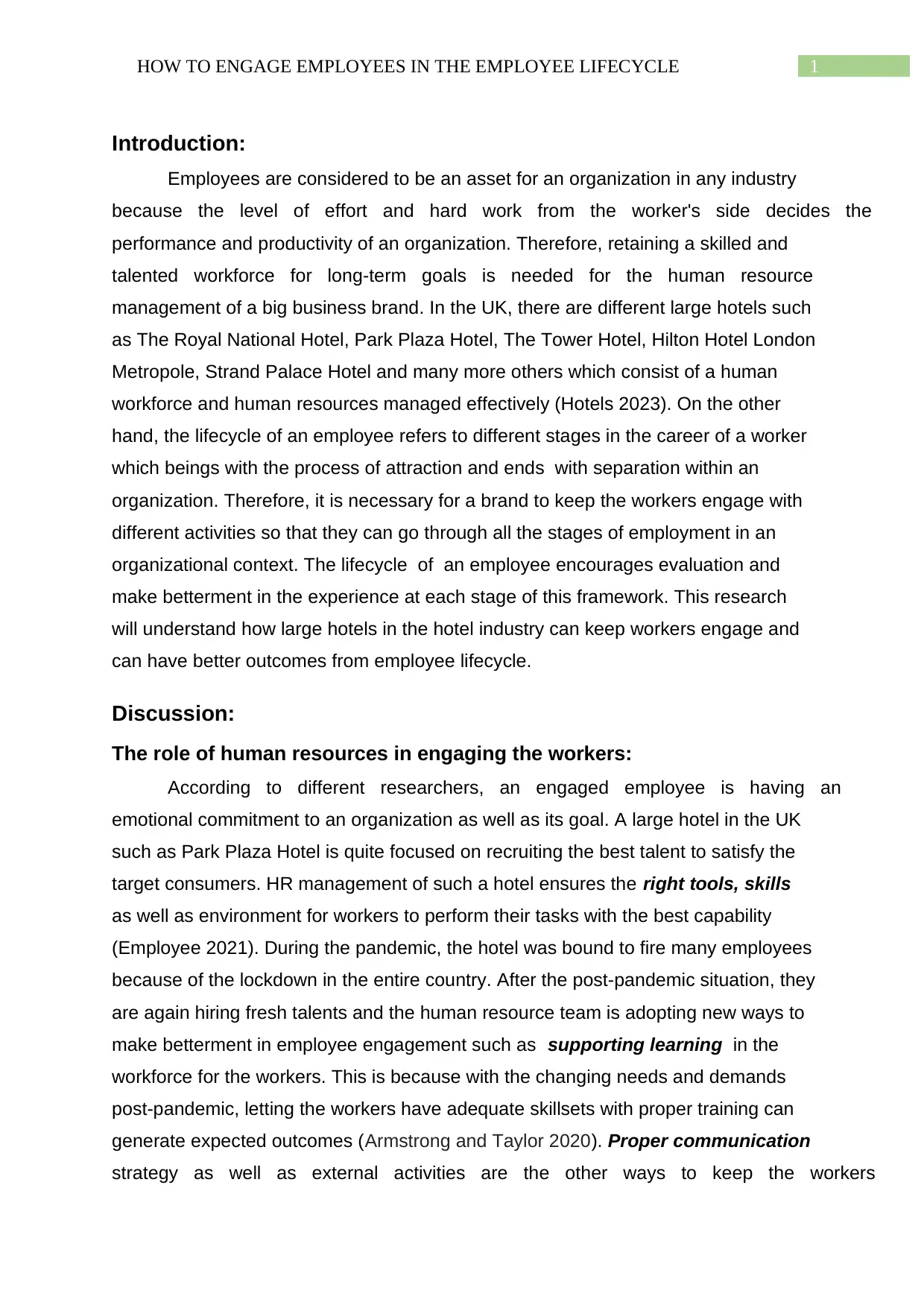
1HOW TO ENGAGE EMPLOYEES IN THE EMPLOYEE LIFECYCLE
Introduction:
Employees are considered to be an asset for an organization in any industry
because the level of effort and hard work from the worker's side decides the
performance and productivity of an organization. Therefore, retaining a skilled and
talented workforce for long-term goals is needed for the human resource
management of a big business brand. In the UK, there are different large hotels such
as The Royal National Hotel, Park Plaza Hotel, The Tower Hotel, Hilton Hotel London
Metropole, Strand Palace Hotel and many more others which consist of a human
workforce and human resources managed effectively (Hotels 2023). On the other
hand, the lifecycle of an employee refers to different stages in the career of a worker
which beings with the process of attraction and ends with separation within an
organization. Therefore, it is necessary for a brand to keep the workers engage with
different activities so that they can go through all the stages of employment in an
organizational context. The lifecycle of an employee encourages evaluation and
make betterment in the experience at each stage of this framework. This research
will understand how large hotels in the hotel industry can keep workers engage and
can have better outcomes from employee lifecycle.
Discussion:
The role of human resources in engaging the workers:
According to different researchers, an engaged employee is having an
emotional commitment to an organization as well as its goal. A large hotel in the UK
such as Park Plaza Hotel is quite focused on recruiting the best talent to satisfy the
target consumers. HR management of such a hotel ensures the right tools, skills
as well as environment for workers to perform their tasks with the best capability
(Employee 2021). During the pandemic, the hotel was bound to fire many employees
because of the lockdown in the entire country. After the post-pandemic situation, they
are again hiring fresh talents and the human resource team is adopting new ways to
make betterment in employee engagement such as supporting learning in the
workforce for the workers. This is because with the changing needs and demands
post-pandemic, letting the workers have adequate skillsets with proper training can
generate expected outcomes (Armstrong and Taylor 2020). Proper communication
strategy as well as external activities are the other ways to keep the workers
Introduction:
Employees are considered to be an asset for an organization in any industry
because the level of effort and hard work from the worker's side decides the
performance and productivity of an organization. Therefore, retaining a skilled and
talented workforce for long-term goals is needed for the human resource
management of a big business brand. In the UK, there are different large hotels such
as The Royal National Hotel, Park Plaza Hotel, The Tower Hotel, Hilton Hotel London
Metropole, Strand Palace Hotel and many more others which consist of a human
workforce and human resources managed effectively (Hotels 2023). On the other
hand, the lifecycle of an employee refers to different stages in the career of a worker
which beings with the process of attraction and ends with separation within an
organization. Therefore, it is necessary for a brand to keep the workers engage with
different activities so that they can go through all the stages of employment in an
organizational context. The lifecycle of an employee encourages evaluation and
make betterment in the experience at each stage of this framework. This research
will understand how large hotels in the hotel industry can keep workers engage and
can have better outcomes from employee lifecycle.
Discussion:
The role of human resources in engaging the workers:
According to different researchers, an engaged employee is having an
emotional commitment to an organization as well as its goal. A large hotel in the UK
such as Park Plaza Hotel is quite focused on recruiting the best talent to satisfy the
target consumers. HR management of such a hotel ensures the right tools, skills
as well as environment for workers to perform their tasks with the best capability
(Employee 2021). During the pandemic, the hotel was bound to fire many employees
because of the lockdown in the entire country. After the post-pandemic situation, they
are again hiring fresh talents and the human resource team is adopting new ways to
make betterment in employee engagement such as supporting learning in the
workforce for the workers. This is because with the changing needs and demands
post-pandemic, letting the workers have adequate skillsets with proper training can
generate expected outcomes (Armstrong and Taylor 2020). Proper communication
strategy as well as external activities are the other ways to keep the workers
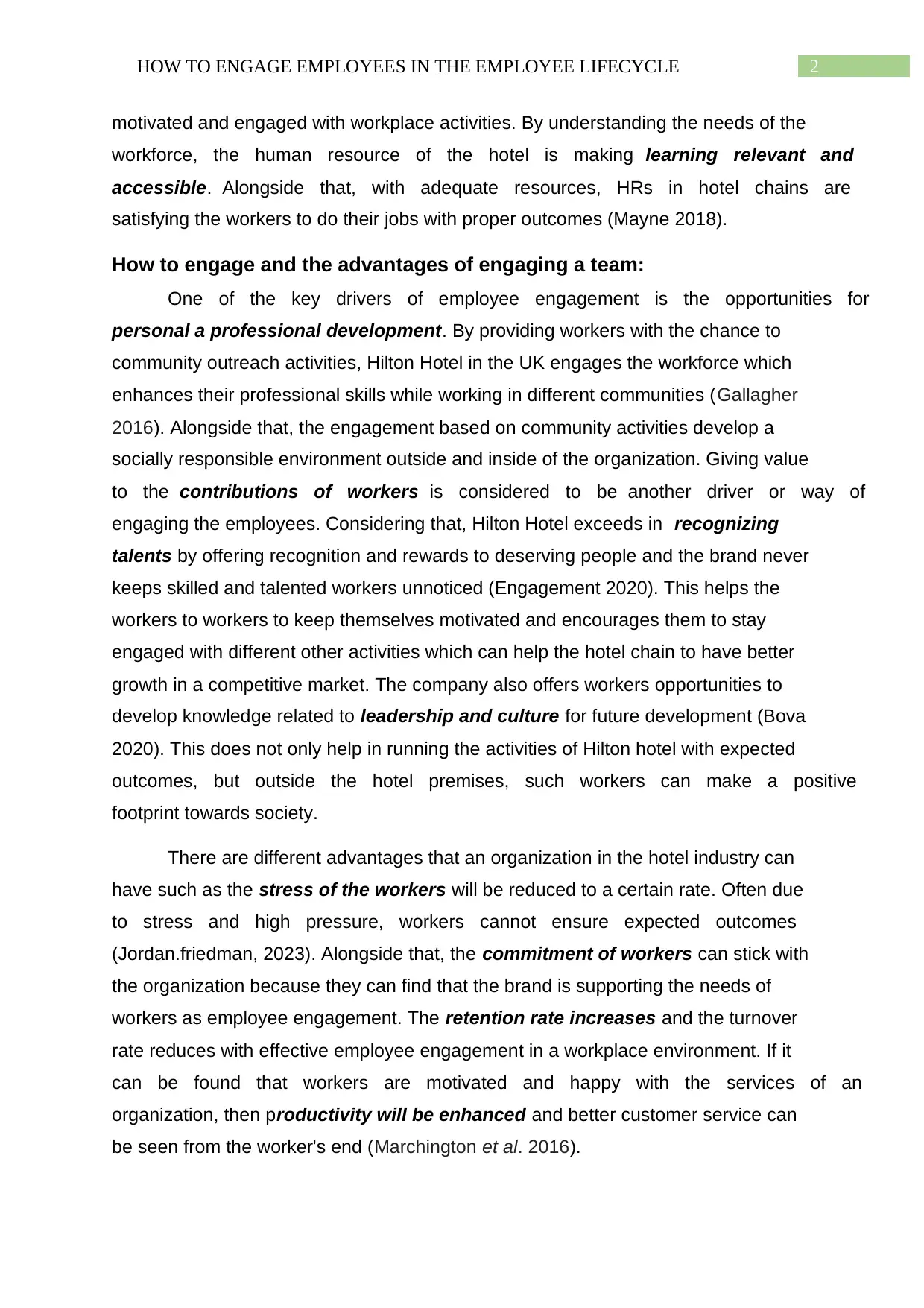
2HOW TO ENGAGE EMPLOYEES IN THE EMPLOYEE LIFECYCLE
motivated and engaged with workplace activities. By understanding the needs of the
workforce, the human resource of the hotel is making learning relevant and
accessible. Alongside that, with adequate resources, HRs in hotel chains are
satisfying the workers to do their jobs with proper outcomes (Mayne 2018).
How to engage and the advantages of engaging a team:
One of the key drivers of employee engagement is the opportunities for
personal a professional development. By providing workers with the chance to
community outreach activities, Hilton Hotel in the UK engages the workforce which
enhances their professional skills while working in different communities (Gallagher
2016). Alongside that, the engagement based on community activities develop a
socially responsible environment outside and inside of the organization. Giving value
to the contributions of workers is considered to be another driver or way of
engaging the employees. Considering that, Hilton Hotel exceeds in recognizing
talents by offering recognition and rewards to deserving people and the brand never
keeps skilled and talented workers unnoticed (Engagement 2020). This helps the
workers to workers to keep themselves motivated and encourages them to stay
engaged with different other activities which can help the hotel chain to have better
growth in a competitive market. The company also offers workers opportunities to
develop knowledge related to leadership and culture for future development (Bova
2020). This does not only help in running the activities of Hilton hotel with expected
outcomes, but outside the hotel premises, such workers can make a positive
footprint towards society.
There are different advantages that an organization in the hotel industry can
have such as the stress of the workers will be reduced to a certain rate. Often due
to stress and high pressure, workers cannot ensure expected outcomes
(Jordan.friedman, 2023). Alongside that, the commitment of workers can stick with
the organization because they can find that the brand is supporting the needs of
workers as employee engagement. The retention rate increases and the turnover
rate reduces with effective employee engagement in a workplace environment. If it
can be found that workers are motivated and happy with the services of an
organization, then productivity will be enhanced and better customer service can
be seen from the worker's end (Marchington et al. 2016).
motivated and engaged with workplace activities. By understanding the needs of the
workforce, the human resource of the hotel is making learning relevant and
accessible. Alongside that, with adequate resources, HRs in hotel chains are
satisfying the workers to do their jobs with proper outcomes (Mayne 2018).
How to engage and the advantages of engaging a team:
One of the key drivers of employee engagement is the opportunities for
personal a professional development. By providing workers with the chance to
community outreach activities, Hilton Hotel in the UK engages the workforce which
enhances their professional skills while working in different communities (Gallagher
2016). Alongside that, the engagement based on community activities develop a
socially responsible environment outside and inside of the organization. Giving value
to the contributions of workers is considered to be another driver or way of
engaging the employees. Considering that, Hilton Hotel exceeds in recognizing
talents by offering recognition and rewards to deserving people and the brand never
keeps skilled and talented workers unnoticed (Engagement 2020). This helps the
workers to workers to keep themselves motivated and encourages them to stay
engaged with different other activities which can help the hotel chain to have better
growth in a competitive market. The company also offers workers opportunities to
develop knowledge related to leadership and culture for future development (Bova
2020). This does not only help in running the activities of Hilton hotel with expected
outcomes, but outside the hotel premises, such workers can make a positive
footprint towards society.
There are different advantages that an organization in the hotel industry can
have such as the stress of the workers will be reduced to a certain rate. Often due
to stress and high pressure, workers cannot ensure expected outcomes
(Jordan.friedman, 2023). Alongside that, the commitment of workers can stick with
the organization because they can find that the brand is supporting the needs of
workers as employee engagement. The retention rate increases and the turnover
rate reduces with effective employee engagement in a workplace environment. If it
can be found that workers are motivated and happy with the services of an
organization, then productivity will be enhanced and better customer service can
be seen from the worker's end (Marchington et al. 2016).
⊘ This is a preview!⊘
Do you want full access?
Subscribe today to unlock all pages.

Trusted by 1+ million students worldwide
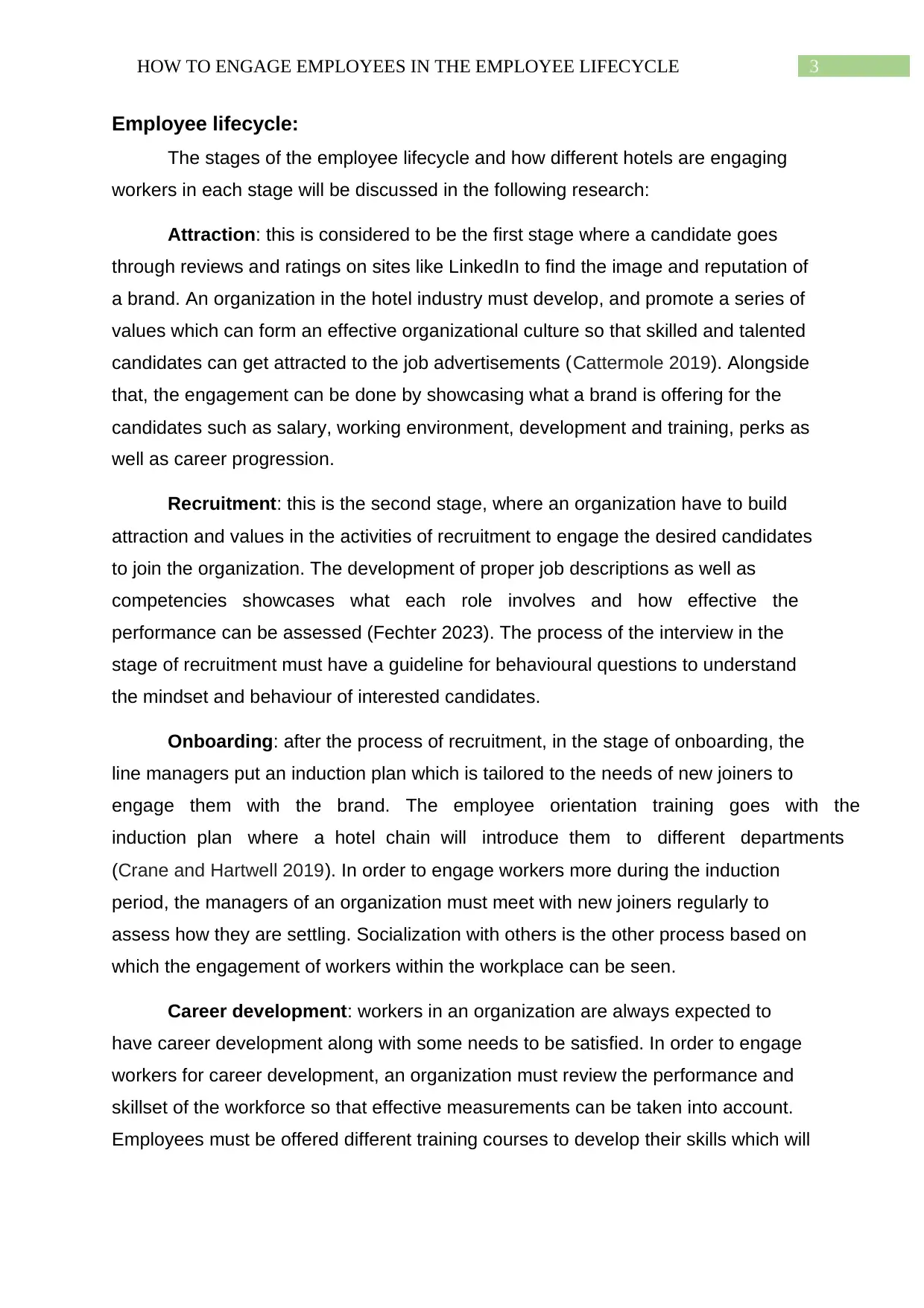
3HOW TO ENGAGE EMPLOYEES IN THE EMPLOYEE LIFECYCLE
Employee lifecycle:
The stages of the employee lifecycle and how different hotels are engaging
workers in each stage will be discussed in the following research:
Attraction: this is considered to be the first stage where a candidate goes
through reviews and ratings on sites like LinkedIn to find the image and reputation of
a brand. An organization in the hotel industry must develop, and promote a series of
values which can form an effective organizational culture so that skilled and talented
candidates can get attracted to the job advertisements (Cattermole 2019). Alongside
that, the engagement can be done by showcasing what a brand is offering for the
candidates such as salary, working environment, development and training, perks as
well as career progression.
Recruitment: this is the second stage, where an organization have to build
attraction and values in the activities of recruitment to engage the desired candidates
to join the organization. The development of proper job descriptions as well as
competencies showcases what each role involves and how effective the
performance can be assessed (Fechter 2023). The process of the interview in the
stage of recruitment must have a guideline for behavioural questions to understand
the mindset and behaviour of interested candidates.
Onboarding: after the process of recruitment, in the stage of onboarding, the
line managers put an induction plan which is tailored to the needs of new joiners to
engage them with the brand. The employee orientation training goes with the
induction plan where a hotel chain will introduce them to different departments
(Crane and Hartwell 2019). In order to engage workers more during the induction
period, the managers of an organization must meet with new joiners regularly to
assess how they are settling. Socialization with others is the other process based on
which the engagement of workers within the workplace can be seen.
Career development: workers in an organization are always expected to
have career development along with some needs to be satisfied. In order to engage
workers for career development, an organization must review the performance and
skillset of the workforce so that effective measurements can be taken into account.
Employees must be offered different training courses to develop their skills which will
Employee lifecycle:
The stages of the employee lifecycle and how different hotels are engaging
workers in each stage will be discussed in the following research:
Attraction: this is considered to be the first stage where a candidate goes
through reviews and ratings on sites like LinkedIn to find the image and reputation of
a brand. An organization in the hotel industry must develop, and promote a series of
values which can form an effective organizational culture so that skilled and talented
candidates can get attracted to the job advertisements (Cattermole 2019). Alongside
that, the engagement can be done by showcasing what a brand is offering for the
candidates such as salary, working environment, development and training, perks as
well as career progression.
Recruitment: this is the second stage, where an organization have to build
attraction and values in the activities of recruitment to engage the desired candidates
to join the organization. The development of proper job descriptions as well as
competencies showcases what each role involves and how effective the
performance can be assessed (Fechter 2023). The process of the interview in the
stage of recruitment must have a guideline for behavioural questions to understand
the mindset and behaviour of interested candidates.
Onboarding: after the process of recruitment, in the stage of onboarding, the
line managers put an induction plan which is tailored to the needs of new joiners to
engage them with the brand. The employee orientation training goes with the
induction plan where a hotel chain will introduce them to different departments
(Crane and Hartwell 2019). In order to engage workers more during the induction
period, the managers of an organization must meet with new joiners regularly to
assess how they are settling. Socialization with others is the other process based on
which the engagement of workers within the workplace can be seen.
Career development: workers in an organization are always expected to
have career development along with some needs to be satisfied. In order to engage
workers for career development, an organization must review the performance and
skillset of the workforce so that effective measurements can be taken into account.
Employees must be offered different training courses to develop their skills which will
Paraphrase This Document
Need a fresh take? Get an instant paraphrase of this document with our AI Paraphraser
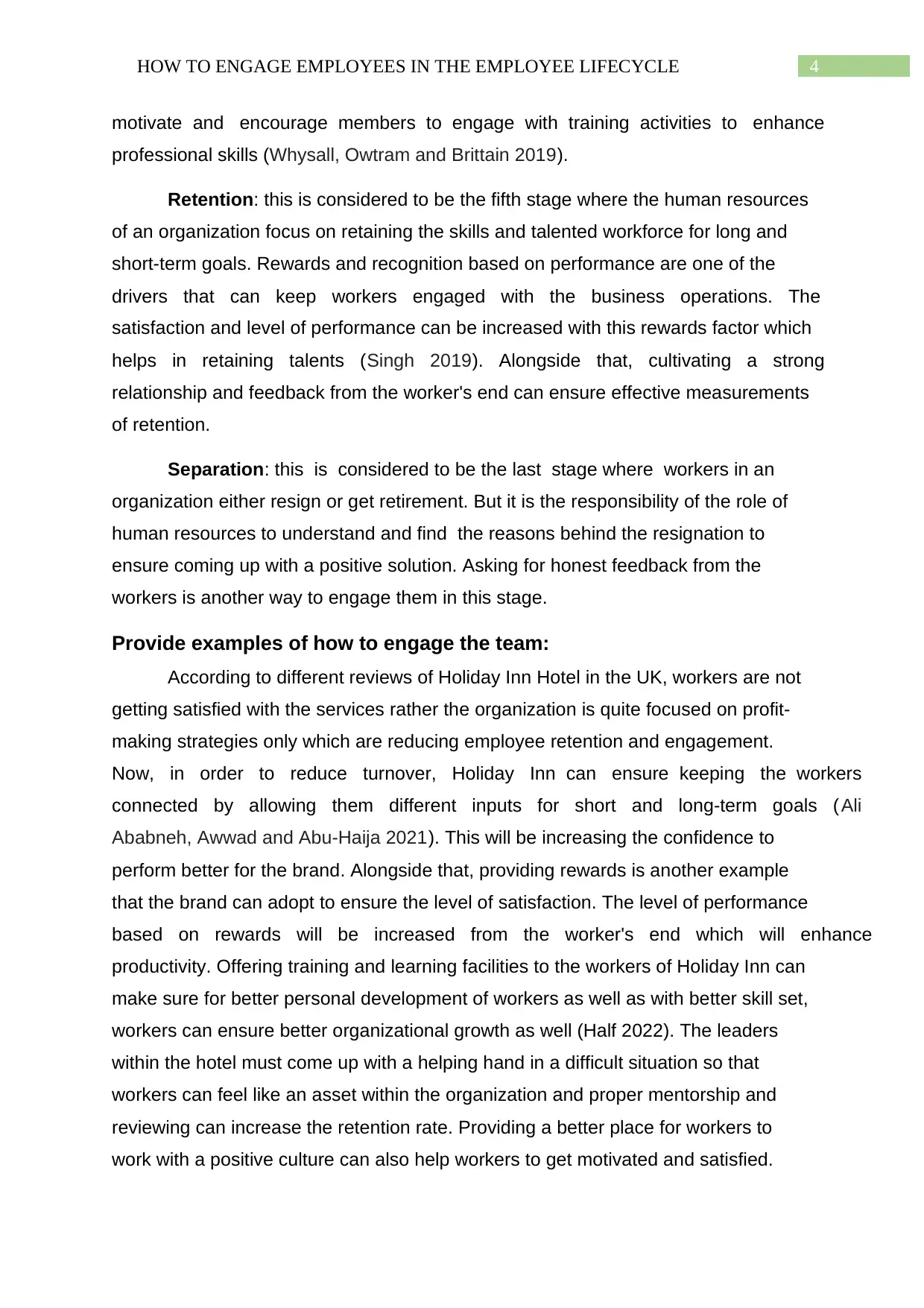
4HOW TO ENGAGE EMPLOYEES IN THE EMPLOYEE LIFECYCLE
motivate and encourage members to engage with training activities to enhance
professional skills (Whysall, Owtram and Brittain 2019).
Retention: this is considered to be the fifth stage where the human resources
of an organization focus on retaining the skills and talented workforce for long and
short-term goals. Rewards and recognition based on performance are one of the
drivers that can keep workers engaged with the business operations. The
satisfaction and level of performance can be increased with this rewards factor which
helps in retaining talents (Singh 2019). Alongside that, cultivating a strong
relationship and feedback from the worker's end can ensure effective measurements
of retention.
Separation: this is considered to be the last stage where workers in an
organization either resign or get retirement. But it is the responsibility of the role of
human resources to understand and find the reasons behind the resignation to
ensure coming up with a positive solution. Asking for honest feedback from the
workers is another way to engage them in this stage.
Provide examples of how to engage the team:
According to different reviews of Holiday Inn Hotel in the UK, workers are not
getting satisfied with the services rather the organization is quite focused on profit-
making strategies only which are reducing employee retention and engagement.
Now, in order to reduce turnover, Holiday Inn can ensure keeping the workers
connected by allowing them different inputs for short and long-term goals ( Ali
Ababneh, Awwad and Abu-Haija 2021). This will be increasing the confidence to
perform better for the brand. Alongside that, providing rewards is another example
that the brand can adopt to ensure the level of satisfaction. The level of performance
based on rewards will be increased from the worker's end which will enhance
productivity. Offering training and learning facilities to the workers of Holiday Inn can
make sure for better personal development of workers as well as with better skill set,
workers can ensure better organizational growth as well (Half 2022). The leaders
within the hotel must come up with a helping hand in a difficult situation so that
workers can feel like an asset within the organization and proper mentorship and
reviewing can increase the retention rate. Providing a better place for workers to
work with a positive culture can also help workers to get motivated and satisfied.
motivate and encourage members to engage with training activities to enhance
professional skills (Whysall, Owtram and Brittain 2019).
Retention: this is considered to be the fifth stage where the human resources
of an organization focus on retaining the skills and talented workforce for long and
short-term goals. Rewards and recognition based on performance are one of the
drivers that can keep workers engaged with the business operations. The
satisfaction and level of performance can be increased with this rewards factor which
helps in retaining talents (Singh 2019). Alongside that, cultivating a strong
relationship and feedback from the worker's end can ensure effective measurements
of retention.
Separation: this is considered to be the last stage where workers in an
organization either resign or get retirement. But it is the responsibility of the role of
human resources to understand and find the reasons behind the resignation to
ensure coming up with a positive solution. Asking for honest feedback from the
workers is another way to engage them in this stage.
Provide examples of how to engage the team:
According to different reviews of Holiday Inn Hotel in the UK, workers are not
getting satisfied with the services rather the organization is quite focused on profit-
making strategies only which are reducing employee retention and engagement.
Now, in order to reduce turnover, Holiday Inn can ensure keeping the workers
connected by allowing them different inputs for short and long-term goals ( Ali
Ababneh, Awwad and Abu-Haija 2021). This will be increasing the confidence to
perform better for the brand. Alongside that, providing rewards is another example
that the brand can adopt to ensure the level of satisfaction. The level of performance
based on rewards will be increased from the worker's end which will enhance
productivity. Offering training and learning facilities to the workers of Holiday Inn can
make sure for better personal development of workers as well as with better skill set,
workers can ensure better organizational growth as well (Half 2022). The leaders
within the hotel must come up with a helping hand in a difficult situation so that
workers can feel like an asset within the organization and proper mentorship and
reviewing can increase the retention rate. Providing a better place for workers to
work with a positive culture can also help workers to get motivated and satisfied.
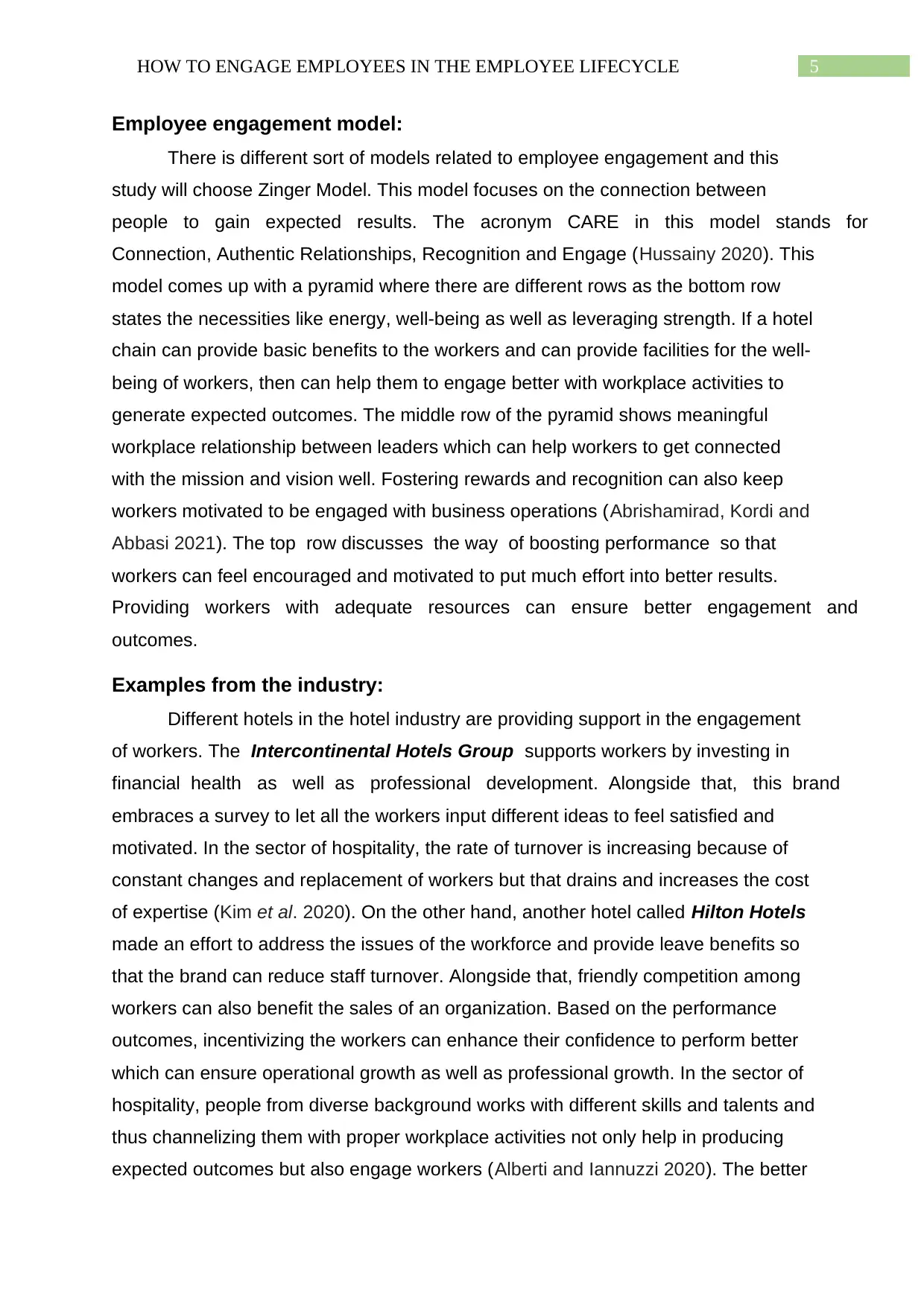
5HOW TO ENGAGE EMPLOYEES IN THE EMPLOYEE LIFECYCLE
Employee engagement model:
There is different sort of models related to employee engagement and this
study will choose Zinger Model. This model focuses on the connection between
people to gain expected results. The acronym CARE in this model stands for
Connection, Authentic Relationships, Recognition and Engage (Hussainy 2020). This
model comes up with a pyramid where there are different rows as the bottom row
states the necessities like energy, well-being as well as leveraging strength. If a hotel
chain can provide basic benefits to the workers and can provide facilities for the well-
being of workers, then can help them to engage better with workplace activities to
generate expected outcomes. The middle row of the pyramid shows meaningful
workplace relationship between leaders which can help workers to get connected
with the mission and vision well. Fostering rewards and recognition can also keep
workers motivated to be engaged with business operations (Abrishamirad, Kordi and
Abbasi 2021). The top row discusses the way of boosting performance so that
workers can feel encouraged and motivated to put much effort into better results.
Providing workers with adequate resources can ensure better engagement and
outcomes.
Examples from the industry:
Different hotels in the hotel industry are providing support in the engagement
of workers. The Intercontinental Hotels Group supports workers by investing in
financial health as well as professional development. Alongside that, this brand
embraces a survey to let all the workers input different ideas to feel satisfied and
motivated. In the sector of hospitality, the rate of turnover is increasing because of
constant changes and replacement of workers but that drains and increases the cost
of expertise (Kim et al. 2020). On the other hand, another hotel called Hilton Hotels
made an effort to address the issues of the workforce and provide leave benefits so
that the brand can reduce staff turnover. Alongside that, friendly competition among
workers can also benefit the sales of an organization. Based on the performance
outcomes, incentivizing the workers can enhance their confidence to perform better
which can ensure operational growth as well as professional growth. In the sector of
hospitality, people from diverse background works with different skills and talents and
thus channelizing them with proper workplace activities not only help in producing
expected outcomes but also engage workers (Alberti and Iannuzzi 2020). The better
Employee engagement model:
There is different sort of models related to employee engagement and this
study will choose Zinger Model. This model focuses on the connection between
people to gain expected results. The acronym CARE in this model stands for
Connection, Authentic Relationships, Recognition and Engage (Hussainy 2020). This
model comes up with a pyramid where there are different rows as the bottom row
states the necessities like energy, well-being as well as leveraging strength. If a hotel
chain can provide basic benefits to the workers and can provide facilities for the well-
being of workers, then can help them to engage better with workplace activities to
generate expected outcomes. The middle row of the pyramid shows meaningful
workplace relationship between leaders which can help workers to get connected
with the mission and vision well. Fostering rewards and recognition can also keep
workers motivated to be engaged with business operations (Abrishamirad, Kordi and
Abbasi 2021). The top row discusses the way of boosting performance so that
workers can feel encouraged and motivated to put much effort into better results.
Providing workers with adequate resources can ensure better engagement and
outcomes.
Examples from the industry:
Different hotels in the hotel industry are providing support in the engagement
of workers. The Intercontinental Hotels Group supports workers by investing in
financial health as well as professional development. Alongside that, this brand
embraces a survey to let all the workers input different ideas to feel satisfied and
motivated. In the sector of hospitality, the rate of turnover is increasing because of
constant changes and replacement of workers but that drains and increases the cost
of expertise (Kim et al. 2020). On the other hand, another hotel called Hilton Hotels
made an effort to address the issues of the workforce and provide leave benefits so
that the brand can reduce staff turnover. Alongside that, friendly competition among
workers can also benefit the sales of an organization. Based on the performance
outcomes, incentivizing the workers can enhance their confidence to perform better
which can ensure operational growth as well as professional growth. In the sector of
hospitality, people from diverse background works with different skills and talents and
thus channelizing them with proper workplace activities not only help in producing
expected outcomes but also engage workers (Alberti and Iannuzzi 2020). The better
⊘ This is a preview!⊘
Do you want full access?
Subscribe today to unlock all pages.

Trusted by 1+ million students worldwide
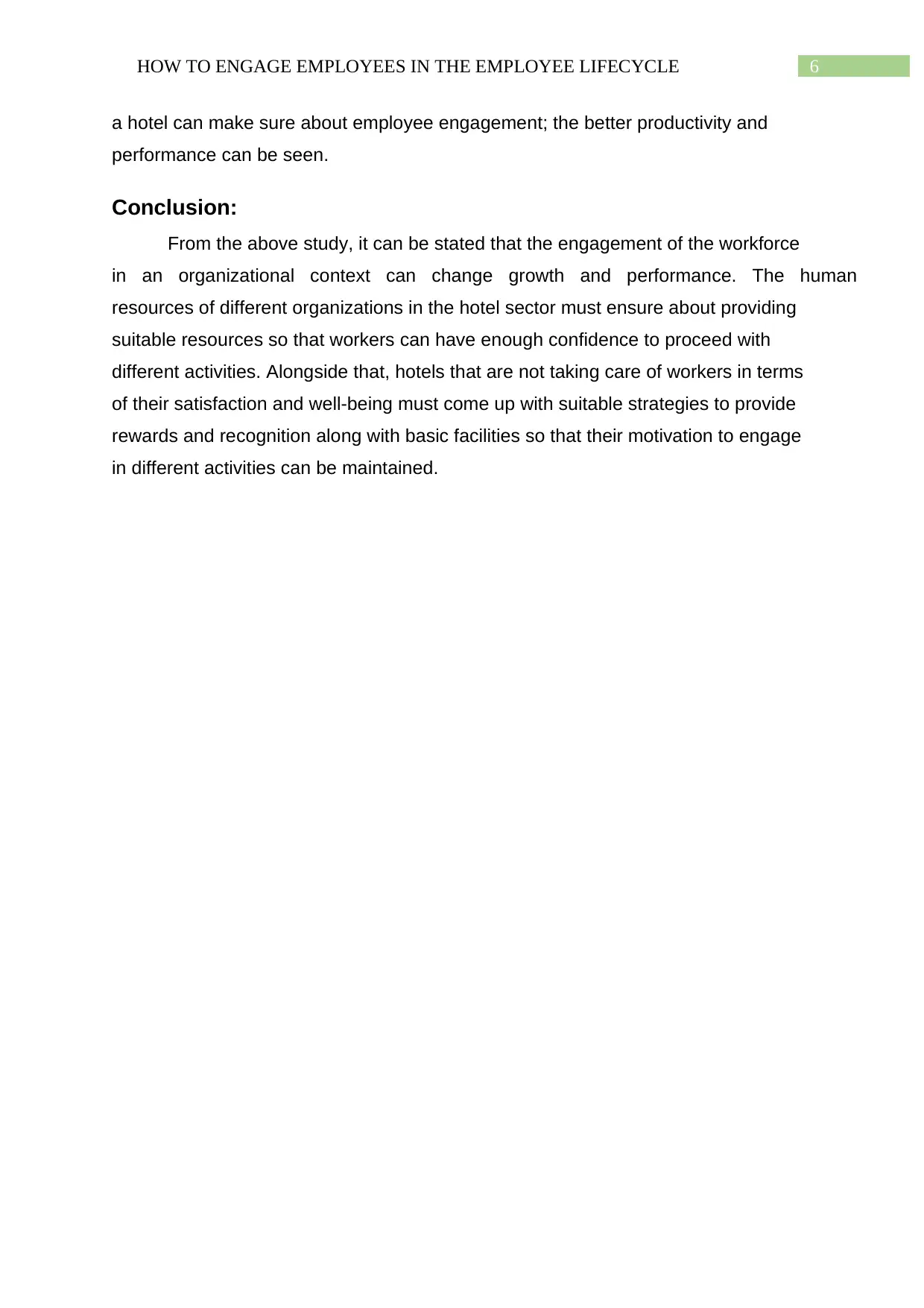
6HOW TO ENGAGE EMPLOYEES IN THE EMPLOYEE LIFECYCLE
a hotel can make sure about employee engagement; the better productivity and
performance can be seen.
Conclusion:
From the above study, it can be stated that the engagement of the workforce
in an organizational context can change growth and performance. The human
resources of different organizations in the hotel sector must ensure about providing
suitable resources so that workers can have enough confidence to proceed with
different activities. Alongside that, hotels that are not taking care of workers in terms
of their satisfaction and well-being must come up with suitable strategies to provide
rewards and recognition along with basic facilities so that their motivation to engage
in different activities can be maintained.
a hotel can make sure about employee engagement; the better productivity and
performance can be seen.
Conclusion:
From the above study, it can be stated that the engagement of the workforce
in an organizational context can change growth and performance. The human
resources of different organizations in the hotel sector must ensure about providing
suitable resources so that workers can have enough confidence to proceed with
different activities. Alongside that, hotels that are not taking care of workers in terms
of their satisfaction and well-being must come up with suitable strategies to provide
rewards and recognition along with basic facilities so that their motivation to engage
in different activities can be maintained.
Paraphrase This Document
Need a fresh take? Get an instant paraphrase of this document with our AI Paraphraser
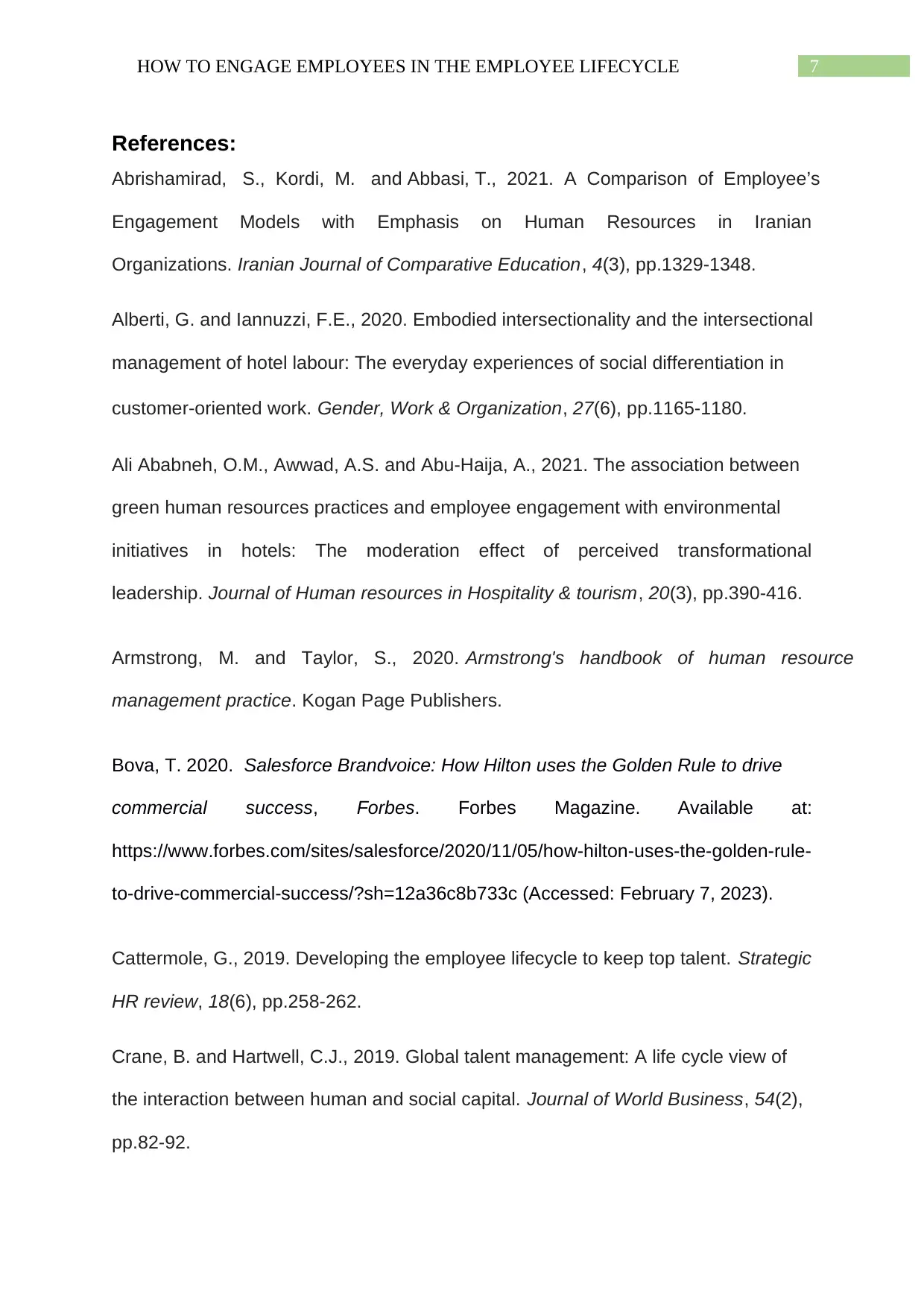
7HOW TO ENGAGE EMPLOYEES IN THE EMPLOYEE LIFECYCLE
References:
Abrishamirad, S., Kordi, M. and Abbasi, T., 2021. A Comparison of Employee’s
Engagement Models with Emphasis on Human Resources in Iranian
Organizations. Iranian Journal of Comparative Education, 4(3), pp.1329-1348.
Alberti, G. and Iannuzzi, F.E., 2020. Embodied intersectionality and the intersectional
management of hotel labour: The everyday experiences of social differentiation in
customer‐oriented work. Gender, Work & Organization, 27(6), pp.1165-1180.
Ali Ababneh, O.M., Awwad, A.S. and Abu-Haija, A., 2021. The association between
green human resources practices and employee engagement with environmental
initiatives in hotels: The moderation effect of perceived transformational
leadership. Journal of Human resources in Hospitality & tourism, 20(3), pp.390-416.
Armstrong, M. and Taylor, S., 2020. Armstrong's handbook of human resource
management practice. Kogan Page Publishers.
Bova, T. 2020. Salesforce Brandvoice: How Hilton uses the Golden Rule to drive
commercial success, Forbes. Forbes Magazine. Available at:
https://www.forbes.com/sites/salesforce/2020/11/05/how-hilton-uses-the-golden-rule-
to-drive-commercial-success/?sh=12a36c8b733c (Accessed: February 7, 2023).
Cattermole, G., 2019. Developing the employee lifecycle to keep top talent. Strategic
HR review, 18(6), pp.258-262.
Crane, B. and Hartwell, C.J., 2019. Global talent management: A life cycle view of
the interaction between human and social capital. Journal of World Business, 54(2),
pp.82-92.
References:
Abrishamirad, S., Kordi, M. and Abbasi, T., 2021. A Comparison of Employee’s
Engagement Models with Emphasis on Human Resources in Iranian
Organizations. Iranian Journal of Comparative Education, 4(3), pp.1329-1348.
Alberti, G. and Iannuzzi, F.E., 2020. Embodied intersectionality and the intersectional
management of hotel labour: The everyday experiences of social differentiation in
customer‐oriented work. Gender, Work & Organization, 27(6), pp.1165-1180.
Ali Ababneh, O.M., Awwad, A.S. and Abu-Haija, A., 2021. The association between
green human resources practices and employee engagement with environmental
initiatives in hotels: The moderation effect of perceived transformational
leadership. Journal of Human resources in Hospitality & tourism, 20(3), pp.390-416.
Armstrong, M. and Taylor, S., 2020. Armstrong's handbook of human resource
management practice. Kogan Page Publishers.
Bova, T. 2020. Salesforce Brandvoice: How Hilton uses the Golden Rule to drive
commercial success, Forbes. Forbes Magazine. Available at:
https://www.forbes.com/sites/salesforce/2020/11/05/how-hilton-uses-the-golden-rule-
to-drive-commercial-success/?sh=12a36c8b733c (Accessed: February 7, 2023).
Cattermole, G., 2019. Developing the employee lifecycle to keep top talent. Strategic
HR review, 18(6), pp.258-262.
Crane, B. and Hartwell, C.J., 2019. Global talent management: A life cycle view of
the interaction between human and social capital. Journal of World Business, 54(2),
pp.82-92.
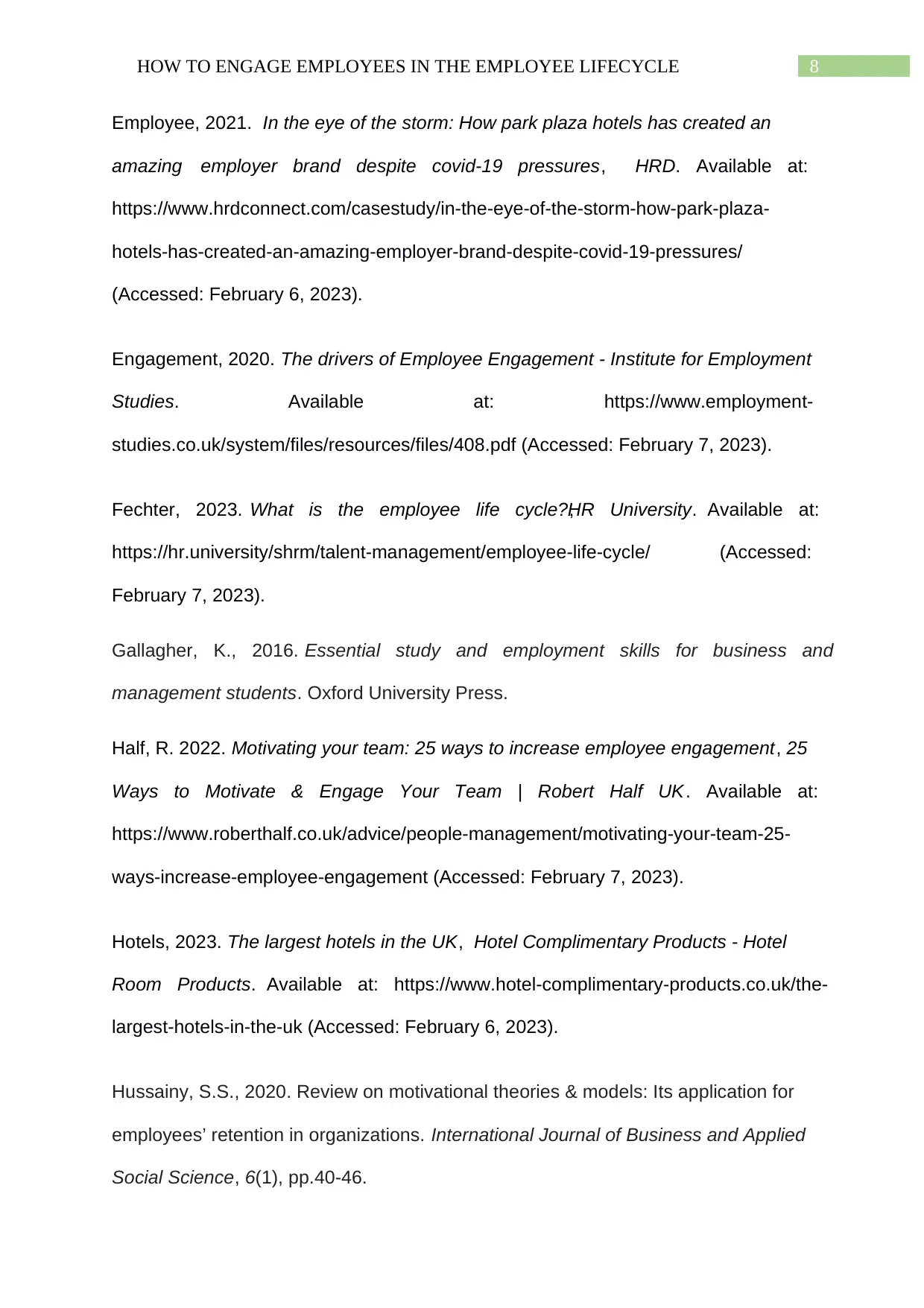
8HOW TO ENGAGE EMPLOYEES IN THE EMPLOYEE LIFECYCLE
Employee, 2021. In the eye of the storm: How park plaza hotels has created an
amazing employer brand despite covid-19 pressures, HRD. Available at:
https://www.hrdconnect.com/casestudy/in-the-eye-of-the-storm-how-park-plaza-
hotels-has-created-an-amazing-employer-brand-despite-covid-19-pressures/
(Accessed: February 6, 2023).
Engagement, 2020. The drivers of Employee Engagement - Institute for Employment
Studies. Available at: https://www.employment-
studies.co.uk/system/files/resources/files/408.pdf (Accessed: February 7, 2023).
Fechter, 2023. What is the employee life cycle?,HR University. Available at:
https://hr.university/shrm/talent-management/employee-life-cycle/ (Accessed:
February 7, 2023).
Gallagher, K., 2016. Essential study and employment skills for business and
management students. Oxford University Press.
Half, R. 2022. Motivating your team: 25 ways to increase employee engagement, 25
Ways to Motivate & Engage Your Team | Robert Half UK. Available at:
https://www.roberthalf.co.uk/advice/people-management/motivating-your-team-25-
ways-increase-employee-engagement (Accessed: February 7, 2023).
Hotels, 2023. The largest hotels in the UK, Hotel Complimentary Products - Hotel
Room Products. Available at: https://www.hotel-complimentary-products.co.uk/the-
largest-hotels-in-the-uk (Accessed: February 6, 2023).
Hussainy, S.S., 2020. Review on motivational theories & models: Its application for
employees’ retention in organizations. International Journal of Business and Applied
Social Science, 6(1), pp.40-46.
Employee, 2021. In the eye of the storm: How park plaza hotels has created an
amazing employer brand despite covid-19 pressures, HRD. Available at:
https://www.hrdconnect.com/casestudy/in-the-eye-of-the-storm-how-park-plaza-
hotels-has-created-an-amazing-employer-brand-despite-covid-19-pressures/
(Accessed: February 6, 2023).
Engagement, 2020. The drivers of Employee Engagement - Institute for Employment
Studies. Available at: https://www.employment-
studies.co.uk/system/files/resources/files/408.pdf (Accessed: February 7, 2023).
Fechter, 2023. What is the employee life cycle?,HR University. Available at:
https://hr.university/shrm/talent-management/employee-life-cycle/ (Accessed:
February 7, 2023).
Gallagher, K., 2016. Essential study and employment skills for business and
management students. Oxford University Press.
Half, R. 2022. Motivating your team: 25 ways to increase employee engagement, 25
Ways to Motivate & Engage Your Team | Robert Half UK. Available at:
https://www.roberthalf.co.uk/advice/people-management/motivating-your-team-25-
ways-increase-employee-engagement (Accessed: February 7, 2023).
Hotels, 2023. The largest hotels in the UK, Hotel Complimentary Products - Hotel
Room Products. Available at: https://www.hotel-complimentary-products.co.uk/the-
largest-hotels-in-the-uk (Accessed: February 6, 2023).
Hussainy, S.S., 2020. Review on motivational theories & models: Its application for
employees’ retention in organizations. International Journal of Business and Applied
Social Science, 6(1), pp.40-46.
⊘ This is a preview!⊘
Do you want full access?
Subscribe today to unlock all pages.

Trusted by 1+ million students worldwide
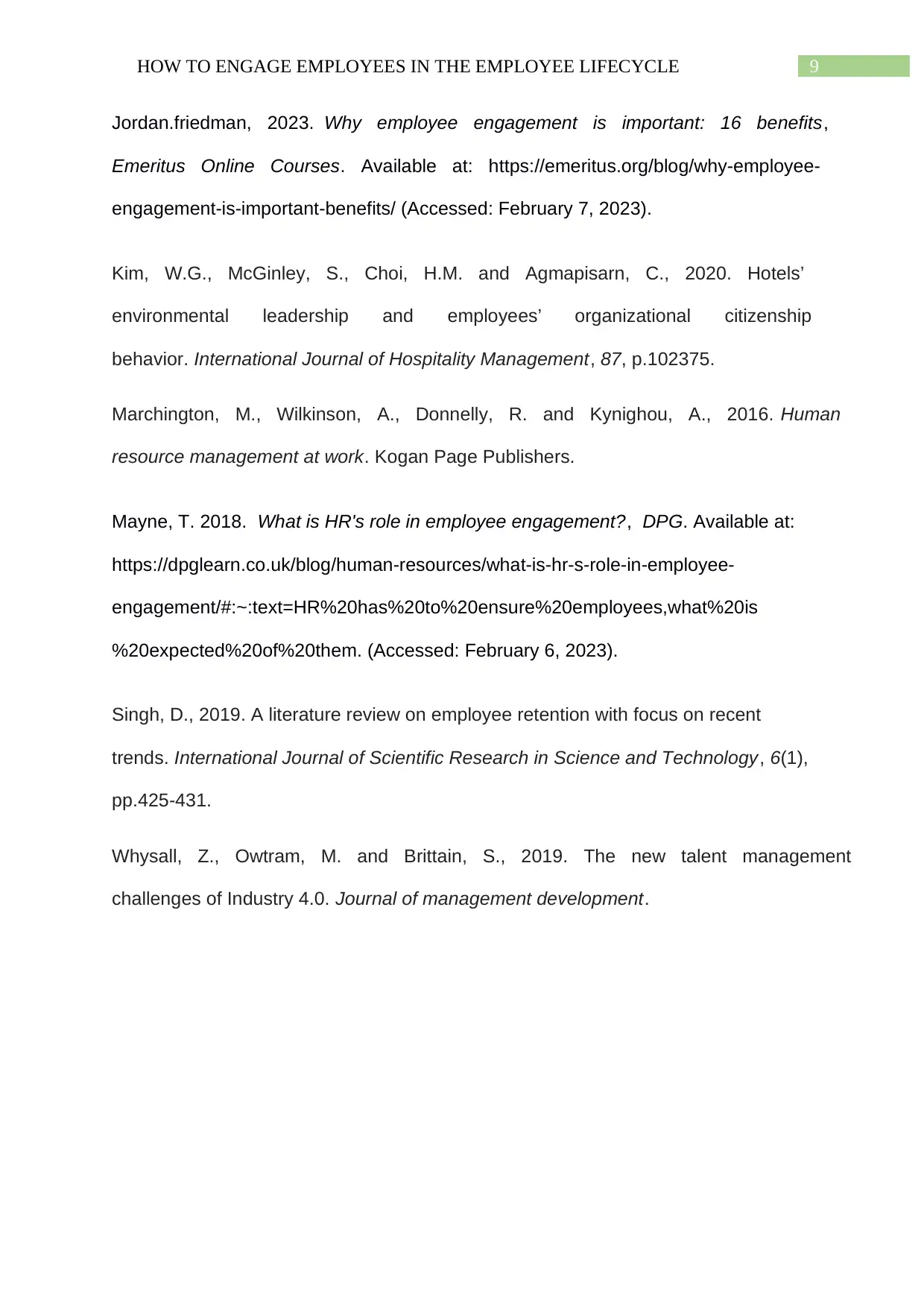
9HOW TO ENGAGE EMPLOYEES IN THE EMPLOYEE LIFECYCLE
Jordan.friedman, 2023. Why employee engagement is important: 16 benefits,
Emeritus Online Courses. Available at: https://emeritus.org/blog/why-employee-
engagement-is-important-benefits/ (Accessed: February 7, 2023).
Kim, W.G., McGinley, S., Choi, H.M. and Agmapisarn, C., 2020. Hotels’
environmental leadership and employees’ organizational citizenship
behavior. International Journal of Hospitality Management, 87, p.102375.
Marchington, M., Wilkinson, A., Donnelly, R. and Kynighou, A., 2016. Human
resource management at work. Kogan Page Publishers.
Mayne, T. 2018. What is HR's role in employee engagement?, DPG. Available at:
https://dpglearn.co.uk/blog/human-resources/what-is-hr-s-role-in-employee-
engagement/#:~:text=HR%20has%20to%20ensure%20employees,what%20is
%20expected%20of%20them. (Accessed: February 6, 2023).
Singh, D., 2019. A literature review on employee retention with focus on recent
trends. International Journal of Scientific Research in Science and Technology, 6(1),
pp.425-431.
Whysall, Z., Owtram, M. and Brittain, S., 2019. The new talent management
challenges of Industry 4.0. Journal of management development.
Jordan.friedman, 2023. Why employee engagement is important: 16 benefits,
Emeritus Online Courses. Available at: https://emeritus.org/blog/why-employee-
engagement-is-important-benefits/ (Accessed: February 7, 2023).
Kim, W.G., McGinley, S., Choi, H.M. and Agmapisarn, C., 2020. Hotels’
environmental leadership and employees’ organizational citizenship
behavior. International Journal of Hospitality Management, 87, p.102375.
Marchington, M., Wilkinson, A., Donnelly, R. and Kynighou, A., 2016. Human
resource management at work. Kogan Page Publishers.
Mayne, T. 2018. What is HR's role in employee engagement?, DPG. Available at:
https://dpglearn.co.uk/blog/human-resources/what-is-hr-s-role-in-employee-
engagement/#:~:text=HR%20has%20to%20ensure%20employees,what%20is
%20expected%20of%20them. (Accessed: February 6, 2023).
Singh, D., 2019. A literature review on employee retention with focus on recent
trends. International Journal of Scientific Research in Science and Technology, 6(1),
pp.425-431.
Whysall, Z., Owtram, M. and Brittain, S., 2019. The new talent management
challenges of Industry 4.0. Journal of management development.
1 out of 10
Related Documents
Your All-in-One AI-Powered Toolkit for Academic Success.
+13062052269
info@desklib.com
Available 24*7 on WhatsApp / Email
![[object Object]](/_next/static/media/star-bottom.7253800d.svg)
Unlock your academic potential
Copyright © 2020–2025 A2Z Services. All Rights Reserved. Developed and managed by ZUCOL.





